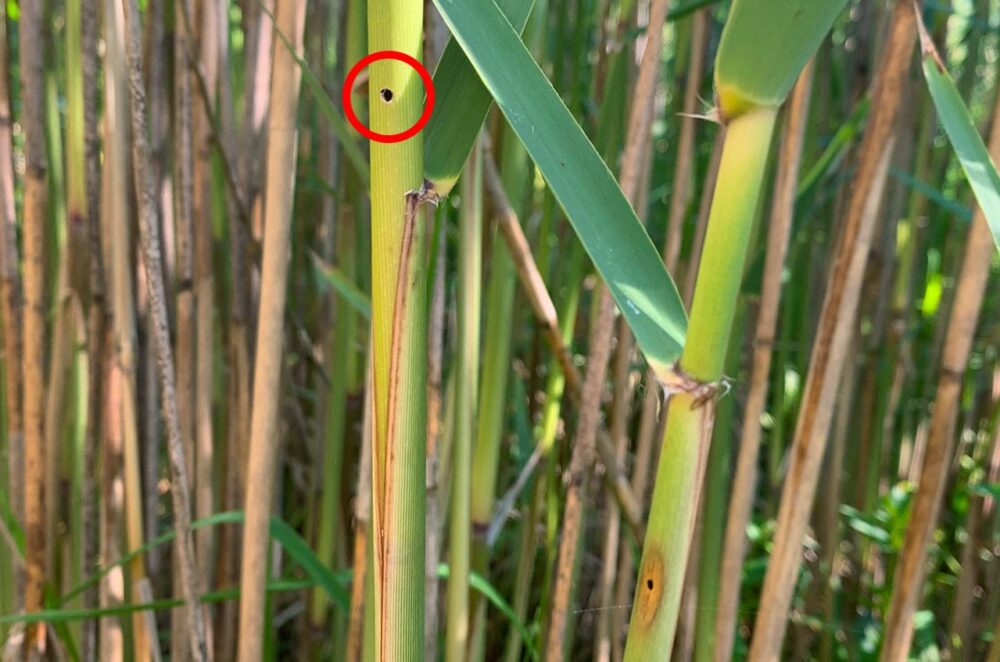- Discover Conservation in Canada
By Province
By Region
By Impact Area
By Program
By Approach
- Get Involved
Attend an Event
Be a Donor
Be a Volunteer
- Be Informed
- About Us
Who we are
What we do
Resources
Two moth species now in the fight against invasive Phragmites

Ducks Unlimited Canada and partners reunite invasive plants with natural enemies.
May 15, 2024, Ontario – Two small but mighty moths are showing promise in controlling the spread of Phragmites australis plants – one of Canada’s most disruptive invasive species. Thanks to the collaboration of Agriculture and Agri-Food Canada, University of Toronto researchers and Ducks Unlimited Canada, (DUC), these moths are being released at select sites across Ontario to tackle the invasive grass that’s devastated wetlands, waterways, and natural areas across the country.
Invasive Species Action Week runs May 12 – 18, so DUC is especially proud to be working with its Canadian collaborators as well as CABI (Centre for Agriculture and Bioscience International in Switzerland) on a partnership to implement biological control for invasive Phragmites, to help protect Canada’s natural spaces from the most disruptive invasive plant in our modern history.
Phragmites thrives in Ontario. It can be found growing on wetland shorelines and in roadside ditches. Unlike the native reed, the invasive form develops into dense thickets that crowd out native plant and animal life. The dense stands block views, fill in access points for swimming and boating, and disrupt water flow in shallow channels and ditches. Waterfronts, beaches and connecting waterways are degraded, diminishing their value for animals and people alike.
Biocontrol uses living organisms to suppress an introduced pest. In the case of weed biological control, natural enemies are employed that specifically attack only the target weed, reducing it’s growth The two stem-boring moths – Archanara neurica and Lenisa geminipuncta are species-specific. Their caterpillars only eat invasive Phragmites stems, not other plant species. Their use is giving researchers a reason to be optimistic that Phragmites has finally met its match. While the moths will not completely eradicate Phragmites, they will gradually reduce the weed’s dominance on the landscape, giving native species a chance to rebound.
“The moths give us hope that the spread of Phragmites can be controlled, allowing native plant communities and ecosystems to recover.” Matt Bolding, invasive species lead, DUC said. DUC is delighted to partner on this project, providing some of the release sites for implementation and helping to build capacity for a largescale release program.”
Modern biocontrol agents undergo extensive study and host-range testing. Development of biocontrol for invasive Phragmites began more than 20 years ago in Europe, followed by more than a decade of testing conducted by an international research team from Switzerland, Canada, and the USA. The moths were approved for release in Canada by the Canadian Food Inspection Agency in 2019.
Since 2020, approximately 21,000 moths have been released at sites across Ontario. The release sites reach from Essex County in the southwest, to North Bay, and east of Ottawa. Release sites are monitored in the summer when tracking the progress of the biocontrol agents is easier. Stems damaged by biocontrol will have one or two boreholes, where the larvae enter and exit the stems, as well as dead or wilted plant tissue where feeding has taken place. Researchers continue to identify damage, which indicates the biocontrol agents can reproduce, overwinter, and disperse locally within release sites.
“Monitoring of the releases has shown that the moth populations are growing at almost all release sites,” Rob Bourchier, research scientist, Agriculture and AgriFood Canada said. “It is hoped that these populations will continue to increase and contribute to the long-term suppression of the Phragmites. We are encouraged by the findings to date and anticipate the moths will prove successful in lessening the destructive impacts of Phragmites going forward.”
Biocontrol agents have been used successfully in the past. In Ontario, populations of purple loosestrife (Lythrum salicaria) were successfully managed through the introduction of two species of Galerucella beetles in the mid-1990s.
To learn more about what DUC is doing to stop the spread of invasive Phragmites, visit: Phragmites Biocontrol in Ontario — Ducks Unlimited Canada
